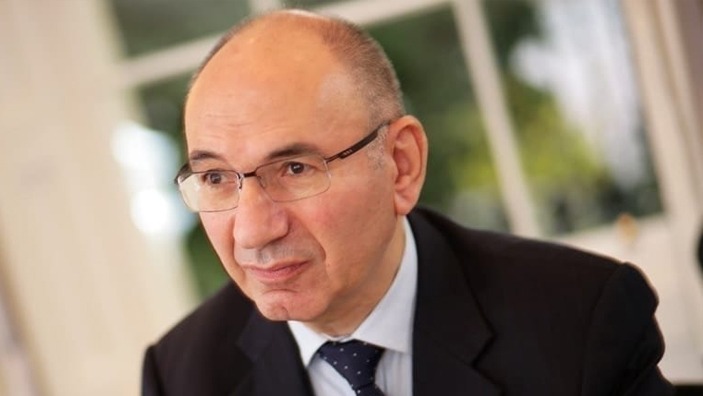Elroy Dimson, Professor of Finance and Chairman of the Centre for Endowment Asset Management at Cambridge Judge Business School, has for decades been known as an expert on markets and long-term investing based on data, data and more data, including a rigorous examination of dozens of global markets over the past 125 years. Yet Elroy says his research journey in this rich world of data launched from a very personal experience, during what he terms a brief detour into the real world of corporations.

With prior experience in operations research, Elroy joined consumer goods giant Unilever in 1970. He says the corporate world was at that time dominated by a stark division between finance and planning teams. Thus, corporate accounts would be developed for the year ahead, but if the Board of Directors baulked at those plans it would often be too late to revise a proposed strategy. The company’s accountants were too often in the driver’s seat. Yet this was also an era when precursors to spreadsheets were being developed, and this helped people like Elroy to build models that guide corporate executives on how various events might shape company fortunes.
“We were able to work out, for example, the impact on Unilever of a rise in the production cost of a given foodstuff,” he recalls. “If there was an increase in the cost of a certain oil the financial effect for Unilever could be alleviated by substituting an alternative, cheaper ingredient.” Corporate modelling made it possible to answer what-if questions and to adapt plans as circumstances changed. “This may seem elementary given today’s technology but it didn’t exist when I began my career, so computerised corporate planning was an eye-opener. The newly launched World Economic Forum (then called the European Management Forum) was the Davos-based venue at which our corporate model was first presented in 1972. I realised there could an exciting link between research and practice and resolved to do a PhD.”
The need for global data to complement US information
Elroy left Unilever in 1972 to pursue a PhD in financial economics at London Business School (LBS). He and others saw that finance textbooks and other key materials were exceptionally US-centric, and believed that there was a “real need for research and teaching material that was more relevant to Britain”. This led to development at LBS of the London Share Price Database (LSPD), covering UK share-price information dating back to 1955 (the dataset now includes 11,000 shares, of which 1,900 are currently live). The LSPD underpinned much of the research, both academic and professional, produced by Elroy and his LBS colleague, Professor Paul Marsh.
Based on LSPD data, in 1978 Elroy and Paul launched a quarterly periodical called the Risk Measurement Service (RMS)[1] that provides estimates of risk and liquidity for every UK company and sector. They describe their approach in a Journal of Finance article[2]. In 1983 they used the LSPD to research a new equity index for the UK. Launched in 1984, the resulting FTSE 100 Index rapidly became the premier yardstick for UK stock market performance.
Building on an article they published in the Journal of Financial Economics in 1987[3], they developed the UK’s leading small-cap index. There is now a complete family of indices covering companies of various sizes. They are now known as the Deutsche Numis Indices. In parallel, they used the LSPD to specify capital requirements for securities businesses. In a Journal of Finance article[4], they analyse the framework, which was passed into UK law in the 1988 Financial Services Act.
In the 1990s, Elroy and Paul, working closely with Dr Mike Staunton – also of London Business School – compiled data on the investment performance of all the main asset classes in a number of other countries. Since 2000, they have published an annual book on global markets. The latest edition, the UBS Global Investment Returns Yearbook 2025, covers 35 markets of which 23 have 125-year histories dating back to 1900.
A clear long-term premium for equities – and a win for the optimists willing to take a bit of risk
This rich data trove led to 2002 publication by the 3 authors of the much-cited book, Triumph of the Optimists[5]. Their book revealed how, from the end of the 19th century, there had been a substantial benefit in every country from owning common stocks rather than traditionally safer investments such as government bonds. Their research documented the universality of the equity risk premium.
Reflecting on the impact of their research, Elroy highlights the title of their book, Triumph of the Optimists: “We had created a long-term database covering many countries, not just the US and UK. It was clear in looking at this data over a century that there was a substantial equity premium. Those who invested in risky equities were handsomely rewarded. The title of our book drew attention to the remarkable returns experienced by those who optimistically invested in commercial and industrial companies. It was the stock market that created wealth over the long haul.”
It was clear in looking at this data over a century that there was a substantial equity premium. Those who invested in risky equities were handsomely rewarded.
Research with Professor David Chambers of Cambridge Judge
More recently, Elroy and David Chambers, Invesco Professor of Financial History at Cambridge Judge and Founder and Co-Director of the Centre for Endowment Asset Management at the Business School, have worked on other aspects of financial market history.
Stemming from a symposium at Cambridge Judge, David and Elroy edited a book, Financial Market History: Reflections on the Past for Investors Today[6], that examines asset returns, stock exchanges and financial bubbles dating back over the centuries. The book was published by the CFA Institute Research Foundation in conjunction with Cambridge Judge.
“Since the 2008 financial crisis, there has been a resurgence of interest in economic and financial history among investment professionals,” David and Elroy write in the book’s Preface. They describe how bubbles are “usually mentioned in the same breath as stock markets”, noting that we can learn how stock market and property bubbles are “very often followed by the onset of financial crises and a variety of policy responses that have been used to reduce the probability of their happening again”.
David and Elroy also explored how Initial Public Offerings in the UK had historically been underpriced – with such underpricing increasing sequentially from the periods 1917 to 1945, 1946 to 1986 and then even more after the UK stock market was deregulated in 1986. “The increase in underpricing is not explained by the composition of firms that undertake an IPO. We suggest several intertwined explanations for this puzzle, led by the reduced level of trust between investors, issuers and sponsors after the Second World War,” concludes the article by David and Elroy in the Journal of Finance[7].
A 2024 study co-authored by David and Elroy in the Annual Review of Financial Economics[8] surveyed academic literature on the historical return premium among stocks, bonds and real assets over the very long run, noting that the number of such studies had grown rapidly in the past quarter-century. They recommended some best-practice measures in compiling and using such long-run data sets, including good documentation of data sources and assumptions, and a focus on possible biases.
Reflections on market trends, AI and fine wine
Here are some of Elroy’s further thoughts on these and other historical trends, how artificial intelligence (AI) may play out in the markets, and how fine wine resonates in his research. These thoughts were spelled out in a recent conversation, and in videos recorded by the CFA Institute, a global not-for-profit organisation that provides finance education for investment professionals. Elroy is an Elected Fellow of the CFA body in the UK.
The parallels between artificial intelligence and past tech breakthroughs
“For investors, I think the contribution of AI will evolve rather like technologies of previous generations,” says Elroy. “The days of many specialist companies with a particular focus such as AI will be limited. In the end, there will be some major success stories. But this will be like early automobile companies – there were perhaps 100 of them in the UK at the start of the 20th century, and only a handful survived. The same happened in my lifetime with computer manufacturers, and in my students’ lifetime with e-businesses.”
Elroy suggests that the story of AI will come to resemble the saga outlined in a 2001 journal article entitled “A Rose.com by any other name”[9], a play on Shakespeare’s famous line from Romeo and Juliet. Raghu Rau, the Sir Evelyn de Rothschild Professor of Finance at Cambridge Judge Business School, outlined in that article how in the dotcom boom many little companies went up in value for a while when .com was added to their name. Many of these dotcom boom firms subsequently collapsed.
Elroy and colleagues launched a small-cap index in the 1980s. “Those small companies did well for a period of time, in part because computers became more accessible and small businesses gained access to more data. They could compete better with large companies. But then large companies took advantage of the big increases in computing power to overtake their smaller counterparts. This may be what we see in the modern AI story: there will be waves, and it won’t be a case where particular types of companies always do better. We will be able to spot these waves, but only with the benefit of hindsight.”
Japan and the US in the post-World War II period
Though it is little commented on today due to Japan’s decades-long economic stagnation, Japan’s market capitalisation in 1988 was the largest in the world following huge growth beginning after World War II. At one point, given the huge rise in property prices in Japan, the Imperial Palace in Tokyo had an estimated value higher than all the land property in California.
“With hindsight we can see that it clearly was a bubble, that Japan had become valuable due to hope value. Step back a few decades, and there was huge agonising among some smaller countries in Europe about how we are going to deal with Japan and the advantages they were creating through their corporate ownership structures and collegial ways of reaching decisions. But in the end the US, with its entrepreneurial spirit, ended up doing much better.”
Elroy says there are other lessons to be learnt from Japan’s 40-year postwar growth, including how long-distance envy can be misplaced. “I don’t care so much whether somebody else is winning a horse race somewhere else,” he says. “This isn’t a race. I want my horse to go fast and produce something valuable. If Japan was ahead of the United States in stock market capitalisation in 1988, good for them. The US was also at its own all-time high in 1989. Then what happened is that the US kept going up and Japan started going down.”
How the BRICS went from growth hype to investment disappointment
The term BRICS, which upon coining in 2001 initially stood for 4 countries expected to grow rapidly – Brazil, Russia, India and China – was soon expanded to also include South Africa, Indonesia and some other growth markets. But expectations ran ahead of the hype, at least as far as investors are concerned.
“There was a widespread belief that dynamism and hunger for growth in the emerging world would lead to those stock markets also doing well, and some banks such as Goldman Sachs had huge enthusiasm for those markets,” says Elroy. “Financial-market researchers like me didn’t challenge this dynamism and growth hunger, but we asked: who benefits? – because this is the key question for investors in those growth markets. People who looked at the documentation of partnerships between listed American and private Chinese companies thought the American partner would get rich, but people who made regular trips to China could see that in fact it was the Chinese company.
“There were benefits to economic growth, but it didn’t go all the way through to the stock market. A look at the data shows that if the stock market goes up, so too (on average) does subsequent economic growth. However, this doesn’t hold true in reverse. If there is favourable economic growth, stock markets do not typically follow with superior performance in subsequent years.”
Norway’s sovereign wealth fund
Elroy chaired the Strategy Council for Norway’s sovereign wealth fund, created to handle the country’s North Sea oil riches, and says he very much enjoyed working with what he terms the fund’s evidence-based approach to investing.
“The oil flowed in the late 1990s, but Norway’s fund like many other such funds took a hit with the dot-com crash of the early 2000s, and there was a lot of public criticism in Norway about how this newfound wealth was being managed.
“The Norwegians, who are known for transparency in governance, decided not to hide but to educate the owners of the Fund, the 5 million-plus Norwegians, and to explain to them why the fund was doing what it is was doing. So the Fund explained to the public matters like the equity risk premium and the advantages of investing globally. The Fund relied heavily on the dataset compiled by Paul Marsh, Mike Staunton and me.”
The changing nature of pension fund management
Elroy was a director of oil company Mobil’s pension fund back in the 1980s and 1990s, and he says that in those days many pension funds had the room to make discretionary decisions regarding individuals that today’s fund managers do not enjoy. And while he is a firm believer in the equity risk premium, pension fund managers may need a more balanced portfolio in this era when most companies have abolished costly defined benefit pension plans that provided set retirement income based on final salary and divorced from investment performance.
“Nowadays there is a much stricter regulatory environment for pension funds amid concerns about meeting liabilities, so I think the right decision is much more nuanced than when I started teaching portfolio management,” he says.
“As outlined in my work for many decades, including for Norway’s sovereign wealth fund, I think many investors should be investing more in equities. But it’s not clear to me that it is the business of the pension fund manager to do that. The business of a pension fund manager may be to look after the absolute requirements that retirees will have for just about getting by. If they want to have lots of exposure to the stock market, then I think that’s more a decision for the individual in today’s world. There isn’t the same opportunity as there was for a pension fund to act paternalistically in what the fund’s trustees think is the best interest of a beneficiary.”
From raisin wine to wine as an investment: a family history
A branch of Elroy’s family made wine from raisins in Lithuania as far back as the 19th century, then upgraded to wine from grapes that eventually made their way to a family-owned wine shop on Commercial Road in London’s East End, where Elroy’s father was born in 1910. While Elroy decided that markets rather than magnums were his calling, these family recollections “resonated with me”, he says, and made their way into his later research on fine wine as an investment.
Examining the period 1900 to 2012, the research found an average real return of 5.4%, which was lowered to 4.1% taking into account storage and insurance costs.
“Over our time frame, wine has been outperformed by equities, and transaction costs could further reduce the relative attractiveness of wine,” says the research published in the Journal of Financial Economics[10]. “However, the performance of wine has been better than that of art and stamps. Moreover, we find evidence of positive correlation between wealth creation and wine prices.”
Elroy’s father died in 2010, and in addition to his knowledge of wine he was an avid stamp collector. That resonated as well.
“This paper uses stamp catalogue prices to investigate the returns on British collectible postage stamps over the period 1900–2008,” says an article co-authored by Elroy and published in 2011, also in the Journal of Financial Economics[11]. “We find an annualised return on stamps of 7.0% in nominal terms, or 2.9% in real terms. These returns are higher than those on bonds but below those on equities.”
A long-term perspective to guide today’s investors and managers
The career of Professor Elroy Dimson illustrates the value of a historical perspective in understanding financial markets over time, and today, illuminating the importance of long-term evidence over short-term speculation and hype. Drawing on his own personal experience in a previous era when technology was only beginning to transform business strategy, Elroy’s research has since examined how risk, return and investor behaviour has evolved over the decades, and the practical lessons this now holds for investors and business executives.
In today’s era, with artificial intelligence emerging as a potent force, Elroy’s work shows how a patient, evidence-based approach has historically been a winning strategy, and how financial market history is not just a dusty record of the past but rather a toolkit that managers can use to navigate today’s challenges. As David Chambers and Elroy Dimson say in the Preface to their book, history “provides academics with plenty of material from which to draw lessons for the benefit of practitioners”.
Featured faculty
Elroy Dimson
Professor of Finance
Chairman of the Centre for Endowment Asset Management (CEAM)
References
[1] Dimson, E. and Marsh, P. (eds.) (2019) Risk measurement service. London: London Business School.
[2] Dimson, E. and Marsh, P. (1983) “The stability of UK risk measures and the problem of thin trading.” Journal of Finance, 38(3): 753-783
[3] Dimson, E. and Marsh, P. (1986) “Event study methodologies and the size effect.” Journal of Financial Economics, 17(1): 1-29
[4] Dimson, E. and Marsh, P. (1995) “Capital requirements for securities firms.” Journal of Finance, 50(3): 821-851
[5] Dimson, E., Marsh, P. and Staunton, M. (2002) Triumph of the optimists. Princeton, NJ: Princeton University Press.
[6] Dimson, E., Marsh, P. and Staunton, M. (2016) “Long-term asset returns.” In: Chambers, D. and Dimson, E. (eds.) Financial market history: reflections on the past for investors today. Charlottesville, VA: CFA Institute Research Foundation, pp.2-26
[7] Chambers, D., Dimson, E., Ilmanen, A. and Rintamakki, P. (2024) “Long-run asset returns.” Annual Review of Financial Economics, 16: 435-458 (DOI: 10.1146/annurev-financial-082123-105515)
[8] Chambers, D. and Dimson, E. (2009) “IPO underpricing over the very long run.” Journal of Finance, 64(3): 1407-1443
[9] Cooper, M.J., Dimitrov, O. and Rau, P.R. (2001) “A rose.com by any other name.” Journal of Finance, 56(6): 2371-2388
[10] Dimson, E., Rousseau, P.L. and Spaenjers, C. (2015) “The price of wine.” Journal of Financial Economics, 118(2): 431-449 (DOI: 10.1016/j.jfineco.2015.08.005) (available online via the SSRN)
[11] Dimson, E. and Spaenjers, C. (2011) “Ex post: the investment performance of collectible stamps.” Journal of Financial Economics, 100(2): 443-458 (DOI: 10.1016/j.jfineco.2010.12.005)





